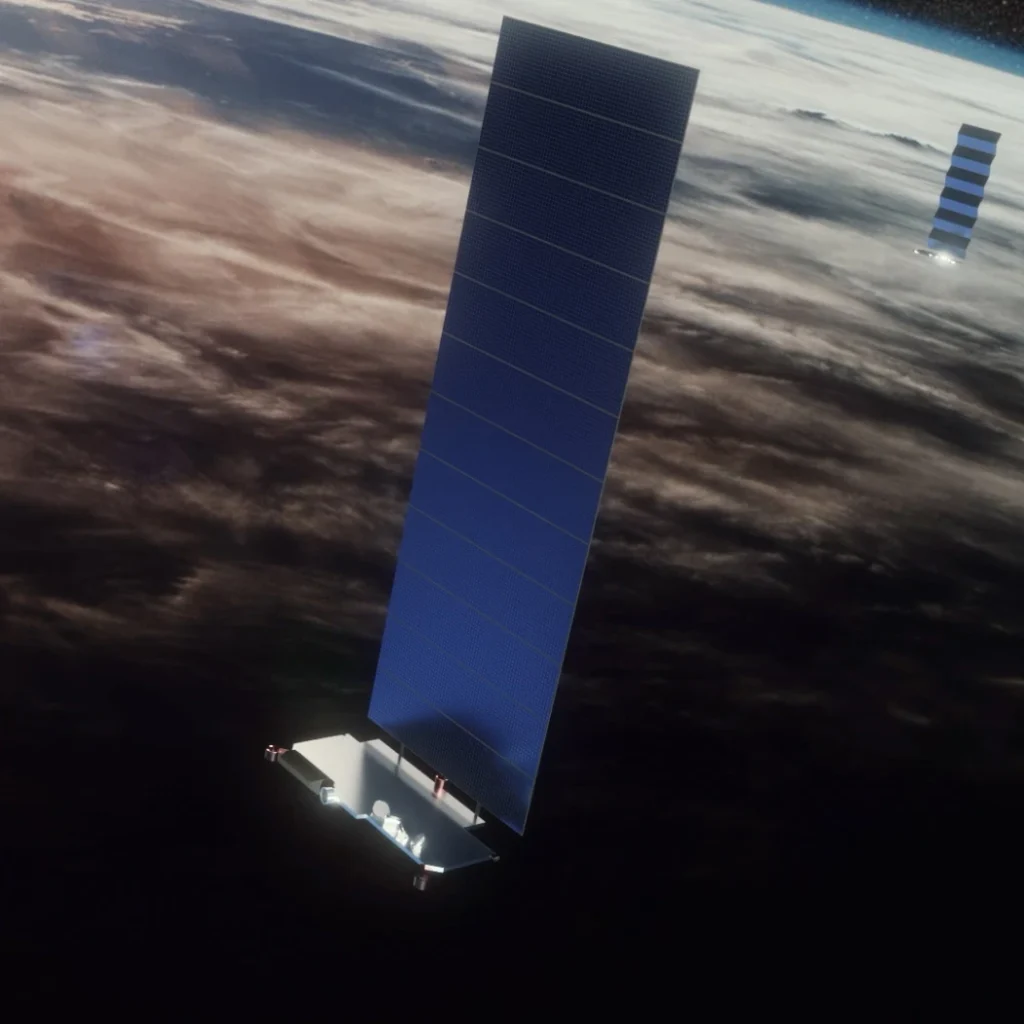Starlink’s Startup Story – Bringing Satellite Internet To Mass Adoption
Starlink, a project by SpaceX, aims to provide high-speed internet to remote and underserved areas worldwide through a constellation of low Earth orbit (LEO) satellites. Founded by Elon Musk, Kimbal Musk, and Gwynne Shotwell in 2014, Starlink has rapidly evolved from concept to a transformative force in global telecommunications.
The Vision: Bridging the Digital Divide
Elon Musk envisioned Starlink as a solution to the global digital divide, where millions lack reliable internet access, particularly in rural and remote areas. By deploying a network of small satellites in LEO, Starlink aims to offer high-speed internet to regions traditionally underserved by terrestrial internet providers.
Early Development and Challenges
The concept of using satellites for internet connectivity isn’t new, but traditional satellite internet has been plagued by high latency and slow speeds due to the use of geostationary satellites. These satellites orbit much higher above the Earth, resulting in significant delays in data transmission.
Elon Musk, along with Greg Wyler, initially collaborated in 2014 to explore the feasibility of a large satellite constellation that could provide low-latency, high-speed internet globally. This early partnership aimed to leverage low Earth orbit (LEO) satellites, which orbit much closer to Earth, significantly reducing latency compared to traditional satellite systems. Although their collaboration eventually ended, the idea persisted and evolved into what is now known as Starlink.
Initial Phase (2015-2016): SpaceX began laying the groundwork for Starlink with significant investments in satellite technology and infrastructure. A satellite development facility was opened in Redmond, Washington. The facility focused on developing small, cost-effective satellites that could be mass-produced. This approach was crucial for the success of Starlink, as thousands of satellites would be needed to provide comprehensive global coverage.The initial focus was on miniaturizing satellite components to reduce costs and increase efficiency. This phase included extensive planning and development, setting the stage for future satellite launches.
One of the key innovations was the design of these satellites to operate in low Earth orbit. This required overcoming significant technical challenges, including the increased drag from the Earth’s atmosphere and the need for efficient propulsion systems to maintain their orbits. SpaceX developed a unique satellite design featuring compact, flat-panel satellites equipped with phased array antennas and Hall-effect thrusters for orbit adjustments and collision avoidance.
First Test Satellites (2018): In February 2018, SpaceX launched its first two test satellites, Tintin A and Tintin B, aboard a Falcon 9 rocket. These prototypes were critical for testing and validating the technology needed for the Starlink network.
First Operational Launch (2019): May 2019 marked a significant milestone with the launch of the first batch of 60 operational Starlink satellites. This launch demonstrated the feasibility of the project and initiated the deployment of a large satellite constellation.
Overcoming Technical Hurdles
Starlink faced numerous technical challenges, including:
- Satellite Design: Developing small, cost-effective satellites capable of efficient operation in LEO.
- Launch Logistics: Coordinating frequent, cost-effective launches to build and maintain the satellite constellation.
- Ground Infrastructure: Creating user-friendly ground terminals for customers to connect to the satellite network.
SpaceX’s expertise in reusable rockets significantly reduced launch costs, making the deployment of a vast satellite network economically viable. The company also developed phased array antennas for user terminals, enabling efficient and reliable communication with the satellites.
Beta Testing and Commercial Launch
Beta Testing (2020): By mid-2020, Starlink began beta testing its service under the program name “Better Than Nothing Beta.” Early adopters, particularly in remote regions, tested the service, providing valuable feedback that helped refine the technology and improve user experience.
Commercial Service Launch (2021): Starlink expanded its beta testing to more regions and began offering pre-orders globally. By the end of 2021, Starlink had launched over 1,700 satellites, providing internet service to customers in North America, Europe, and other parts of the world. The service quickly gained traction, with over 500,000 orders placed by mid-2021 and nearly 100,000 active users by June 2021.
Growth and Impact
Expansion and Scaling (2022-2023): Starlink continued to increase its satellite launches, aiming for a constellation of approximately 12,000 satellites, with plans to more than tripple this number in the near future. The service expanded to more countries, providing reliable internet access to remote and underserved areas globally. By 2023, Starlink had reached over two million subscribers, driven by continuous improvements in technology and expanding coverage.
Financial Performance
Starlink’s financial growth has been impressive. In 2022, the company generated $1.4 billion in revenue, a significant increase from $222 million in 2021. This growth is largely attributed to the increasing subscriber base and the expansion of its satellite network. Starlink aims to use the revenue generated from its internet services to fund SpaceX’s more ambitious projects, such as missions to Mars.
Strategic Partnerships: What helpde Starlink grow faster was that it partnered with major retailers like Best Buy, Home Depot, and Costco to distribute its hardware. Additionally, agreements with telecommunications providers like T-Mobile, One (New Zealand), and Telstra (Australia) further extended its reach and service capabilities.
Starlink Today: Transforming Global Internet Connectivity in 2024/25
Expanded Global Reach
As of 2024, Starlink serves over 2.6 million users worldwide, spanning residential, maritime, and aviation sectors. This rapid growth underscores the increasing demand for reliable, high-speed internet access, particularly in remote and underserved areas. The satellite constellation, consisting of thousands of small satellites in low Earth orbit (LEO), provides coverage across North America, Europe, and several other regions.
Technological Advancements
Starlink’s technological capabilities have seen significant improvements. The service currently offers speeds between 100 and 200 megabits per second (Mbps) with plans to increase this to 10 gigabits per second (Gbps) in the future. This performance is achieved through continuous upgrades to both the satellite constellation and user terminals.
One of the notable advancements is the reduction in latency, which has been a critical factor in improving user experience for activities like streaming, online gaming, and video conferencing. The goal is to maintain a stable median latency of 20 milliseconds, which is competitive with traditional broadband services.
The company’s business model also includes plans to offer specialized services for the aviation industry, providing high-speed internet to airlines and private jet operators. This diversification into different market segments highlights Starlink’s adaptability and its commitment to expanding its service offerings.
Challenges and Controversies
Despite its successes, Starlink faces several challenges. The brightness of the satellites has raised concerns among astronomers, leading to potential interference with night sky observations. Starlink has taken steps to mitigate these issues by implementing anti-reflective coatings on newer satellites.
Additionally, the rapid expansion of the satellite constellation has necessitated regulatory approvals and scrutiny. Ensuring compliance with local and international regulations is crucial for maintaining the growth trajectory of Starlink’s services.
Future Prospects
Looking ahead, Starlink aims to achieve near-global coverage by the mid-2020s, with a constellation of up to 42,000 satellites. The company continues to innovate, with plans to introduce new products and services that cater to both residential and commercial customers. Starlink’s ongoing efforts to enhance its technology and expand its reach underscore its potential to revolutionize global internet connectivity.
In Summary
Starlink’s startup story is a testament to innovation and the drive to solve complex global challenges. From its ambitious vision to its current achievements, Starlink has significantly impacted global internet connectivity, offering high-speed internet access to remote and underserved regions. As the project continues to evolve, it promises to play a pivotal role in the future of global communication and internet access.
Sources
- Starlink — Complete Guide: History, Products, Founding, and More (History-Computer)
- Analyzing The Starlink Business Model (starlinkinsider.com)
- Starlink Technology (Starlink)
- Starlink Official Website (Starlink)
- Space.com
- Inverse.com
- PCMag
- livescience.com







